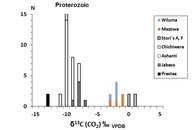Simultaneous measurements of isotopic compositions of fluid inclusion gases
Isotopic measurements of natural gas mixtures are of considerable interest, for example in hydrocarbon exploration, volcanic fields or modern submarine hydrothermal systems. However, in areas where free gases are absent, gases trapped in mineral-hosted fluid inclusions can provide pointers to gas origin and paleo gas migration.
Fluid inclusions are small liquid and/or vapor-filled vacuoles in minerals that were formed either during crystal growth as primary or pseudo secondary inclusions or after crystallization as secondary fluid inclusions when a crystal was fractured in the presence of a fluid which could penetrate into the fractures and re-crystallize the host mineral. Fluid inclusions consist at least of one phase (liquid or vapor), but most common are two-phase inclusions where a liquid and a vapor phase are present. The vapor phase(s) of fluid inclusions may consist of steam but also of gases such as CO2, CH4, and/or N2. The isotopic compositions of trapped gases in fluid inclusions hosted in minerals that precipitated in different geological environments (e.g. magmatic, hydrothermal, and sedimentary) can provide important information about the origin, generation and migration of natural gases.
A new on-line method for simultaneous measurements of stable isotope ratios of N2, CH4, and CO2 in small amounts of natural gas mixtures released by crushing of fluid inclusions was developed at the GFZ using a sample crusher, gas chromatography (GC), an elemental analyzer (EA), and continuous-flow isotope ratio mass-spectrometry (CF-IRMS).
The δ13C (CO2) values of quartz-hosted fluid inclusions from some Archean and Proterozoic orogenic gold deposits yield different sources for CO2 in the studied deposits.
Participants
- Dr. Volker Lüders
- Dr. Birgit Plessen (Section 5.2)
Publications
- Lüders V, Plessen B, di Primio R (2012) Stable carbon isotopic ratios of CH4-CO2-bearing fluid inclusions in fracture-fill mineralization from the Lower Saxony Basin (Germany) – a tool for tracing gas sources and maturity. Marine and Petroleum Geology 30: 174-183
- Plessen B, Lüders V (2012) Simultaneous measurements of gas isotopic compositions of fluid inclusion gases (N2, CH4, CO2) using continuous-flow isotope ratio mass spectrometry. Rapid Communications in Mass Spectrometry 26: 1157-1161
- Sośnicka M, Lüders V (2013) Stable isotope analyses of fluid inclusions: Constraints for the formation of high-grade Fe ore, Krivoy Rog, Ukraine. MINERAL DEPOSIT RESEARCH FOR A HIGH-TECH WORLD, 12th SGA Biennial Meeting 2013. Proceedings, Volume 2: 738-741
- Lüders V, Plessen B (2015) Stable carbon isotope ratios of CH4-rich gas inclusions in shale-hosted fracture-fill mineralization: A tool for tracing hydrocarbon generation and migration in shale plays for oil and gas. Marine and Petroleum Geology 63: 68-81
- Lüders V, Klemd R, Oberthür T, Plessen B (2015) Different carbon reservoirs of auriferous fluids in African Archean and Proterozoic gold deposits? Constraints from stable carbon isotopic compositions of quartz-hosted CO2-rich fluid inclusions. Mineralium Deposita, DOI 10.1007/s00126-015-0588-x



